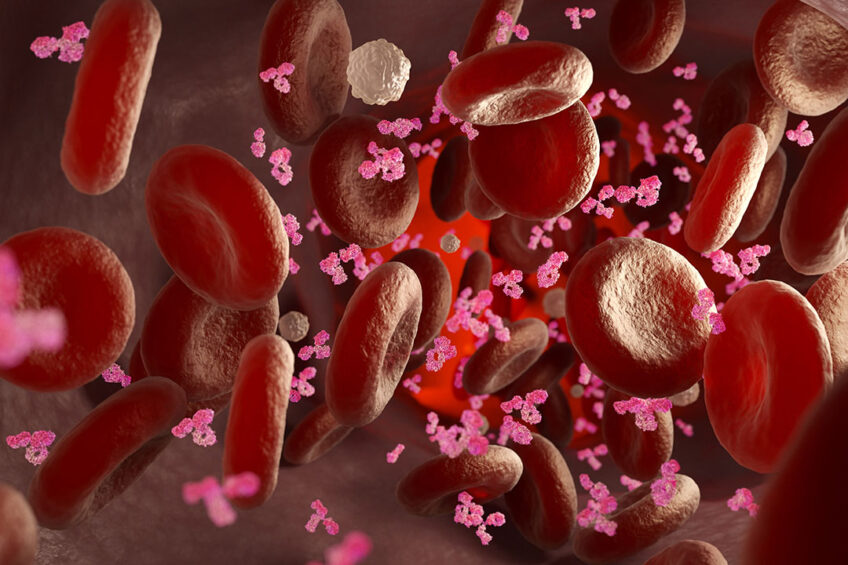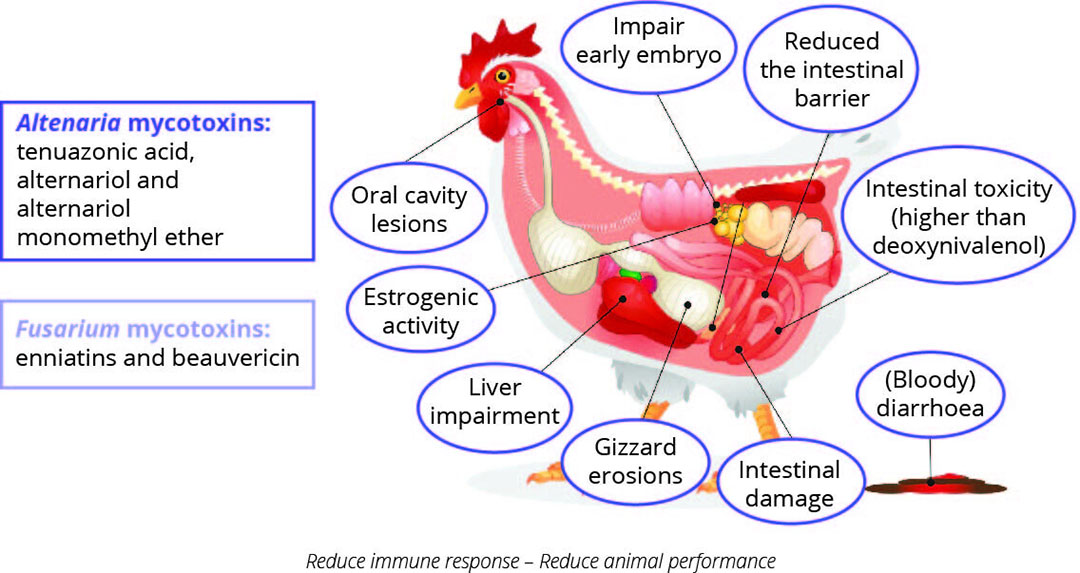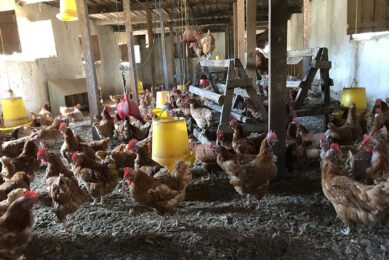Using blood biomarkers to detect emerging mycotoxins

For the first time it is possible to achieve what the scientific community for a long time theorised as the best method to correctly assess the true exposure of animals to mycotoxins, by detecting them and their metabolites in bodily fluids, in this case blood. The novel findings demonstrate that current practices for detecting mycotoxin risk in feed alone, are not up to the task.
Innovad has validated and patented a method to currently determine 36 different mycotoxin biomarkers in blood using so-called FTA cards. The cards offer a simple means to easily collect blood spots and dispatch them for analysis to their lab without restrictions. The blood analysis, applied with the Myco-Marker service, provides for the first time a picture of the true in vivo mycotoxin threat. The Myco-Marker service was launched one year ago and more than 1,000 samples from around the world have been already tested. The considerable volume of analytes tested have enabled an unprecedented reliable assessment of the real mycotoxin exposure in farms. More importantly, it has also demonstrated that feed analysis alone does not provide a sufficient overview of the mycotoxin risk. The added value of combining feed and blood analysis to uncover mycotoxin risk revealed that most cases (80%) of mycotoxin exposure would have been missed if only feed was analysed.
Real risk discovered through biomarkers
Myco-Marker service identified mycotoxin risk in all the studied farms and more than 50% of them were co-exposed to 5 or more mycotoxins, one of the most remarkable outcomes is the discovery of a large presence of so-called emerging mycotoxins in the blood from swine and poultry animals. These mycotoxins are considered emerging because our knowledge about them is only now evolving and emerging and yet they are the most persistent and predominant mycotoxins detected in blood samples by the service (Table 1).
Tenuazonic acid, an emerging mycotoxin produced by Alternaria species, was the most frequent in 68 and 66% of the swine and poultry farms, respectively followed by other emerging mycotoxins, like the enniatins, produced by Fusarium spp. Enniatin B1 was the second most common mycotoxin detected in blood whereas, enniatin B and beauvericin (also produced by Fusarium) were within the top 5 recurrent mycotoxins detected. Based on this most extensive blood dataset known to date, these highly toxic compounds were shown to occur in all geographical areas and tenuazonic acid was the most frequent mycotoxin detected around the world. Other emerging mycotoxins such as alternariol (8%), alternariol monomethyl ether (11%) (both produced also by Alternaria) and enniatin A1 (23%) were also identified in the blood samples.
Interestingly, the large exposure to emerging mycotoxins detected in the global blood survey from Innovad agrees with large-scale feed surveys published in the last 2 years, which reported vastly the prevalence of emerging mycotoxins. For example, enniatin B1 was detected in 92% of the collected finished feed swine samples (n=526), even more common than deoxynivalenol (88%), while tenuazonic acid was detected in 73% of the samples. The same feed survey also revealed that emerging mycotoxins were in fact even more frequently detected than other mycotoxins typically included in the routine analysis such as fumonisins (63%) or T-2 (45%). All these new data lead one to the significant conclusion that livestock are undoubtedly being widely exposed to mycotoxins, far more than we once thought, and that emerging mycotoxins are the most predominant.
Figure 1 – The post profound toxic effects caused by emerging mycotoxins produced by Alternaria and Fusarium species.

Toxic consequences
The toxic impact of these emerging mycotoxins started to be investigated and all the new findings raise serious concerns about the harmful character of these mycotoxins (Figure 1). Most of the Alternaria mycotoxins are well known to have estrogenic activity as they are able to bind and activate estrogen receptors. In other words, they cause reproductive problems. This is relevant as up until recently it was generally believed that zearalenone was the only mycotoxin that can cause these type of symptoms. For example, Myco-Marker via its introductory year as a diagnostic service, revealed that 83% of the cases with sows presenting reproductive problems suffered systemic exposure to zearalenone or Alternaria mycotoxins. Interestingly, Crudo and co-authors (2019) demonstrated recently that the co-occurrence of Alternaria mycotoxins with zearalenone can potentiate a synergistic estrogenic toxic effect in sows. On the other hand, tenuazonic acid can seriously damage intestinal tissues and induce intestinal haemorrhage where even sub-acute exposure has been linked with bloody diarrhoea in poultry. Other severe symptoms like gizzard erosions and liver impairment have also been connected to tenuazonic acid exposure.
With regards to emerging Fusarium mycotoxins (enniatins and beauvericin), all studies reveal that they can exert a significant negative impact on intestinal tissues. Enniatin A1 was twice as toxic than deoxynivalenol (DON) in swine intestinal cells (IPEC-1). In vitro studies also demonstrated a toxic effect of beauvericin and enniatins on the reproductive system as they all altered the production of sexual hormones such as estradiol and progesterone. Also, beauvericin impaired the development of swine oocytes and early embryos.
Co-exposure to emerging mycotoxins
The correlation between performance reduction and exposure to emerging mycotoxins has also been established. One recent study reported that exposure to beauvericin and enniatins, even at low concentrations (considered safe levels and not causing any apparent symptoms), increased the feed conversion rate in broilers. Similarly, chronic exposure to tenuazonic acid lowered the weight gain in broilers. All mycotoxins exert some level of immunocompromising effect and data from several studies suggest that these emerging mycotoxins can impair the immune response, therefore, predisposing animals to other diseases and infections as well.
Several clinical studies having demonstrated that co-exposure to mycotoxins exerts a synergistic or negative additive toxic impact, the high level of co-exposure to several emerging mycotoxins in our global blood survey via Myco-marker raises concerns. This is especially true given the high rate of emerging mycotoxins where for example, enniatin B and beauvericin or enniatin B and alternariol combinations were linked with significant toxic effects to the farmed animals.
Reducing exposure to emerging mycotoxins
According to the scarce existing information, emerging mycotoxins are not easily bound by the most widely used binders – clays. However, Innovad’s Escent S detoxifier technology has recently demonstrated the ability to reduce the systemic exposure to emerging mycotoxins.
2 chicken groups were tested:
- control group, under a competitor technology (1kg/T) and
- treatment group under Escent S (1kg/T) and the true mycotoxin risk was assessed with the Myco-Marker tool.
While 50% of the animals from the control group (competitor technology) were systemically exposed to emerging mycotoxins (tenuazonic acid and beauvericin), no detectable levels of emerging mycotoxins were identified in the blood of animals under Escent S. The results of the field trial demonstrated that the choice of technology in reducing the exposure to emerging mycotoxins is not irrelevant.
Uncover the ignored and solve the problem
In conclusion, the use of blood biomarkers in a global survey in poultry and swine revealed a significant, in fact dominating, presence of emerging mycotoxins. It appears that animals are persistently exposed more to these toxins than the well-known top 5 mycotoxins, typically included in a routine analysis. The implication being that most current mycotoxin control programmes will not in fact detect the emerging mycotoxins and will underestimate the true exposure and thereby ultimately fail. This is a significant breakthrough, as it highlights that the establishment of an extensive mycotoxin biomarker monitor plan, including emerging mycotoxins, is crucial to optimise appropriately the mitigation strategies and improve not only the animal health status but also animal performance. Equally, if not more important, the choice of technology in reducing the exposure to emerging mycotoxins remains key and Escent S has already gathered some very promising data towards this.
References available on request.






